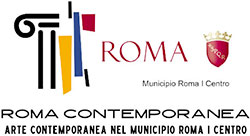The artworks on display are all unitedy by the black and white theme: sculptures, paintings, drawings and embroidered canvas blend into a bi-colored dimension, arousing amazement and meditation.
Absence and sum of all colors, black and white, in art, have always had the power to generate immediate tension, to create disorentation and to communicate without any other intermediary but themselves. Despite their apparent simplicity, these colors fill the space and communicate with the viewer. They have the ability to hold the whole universe within them, like the alpha and the omega. They are the excesses of the same world.
Each artist exhibits one or more significative piece of art, that are emblematic of their work.
"Bamboo forest" (2015) is the work by Julian Opie (1968), a stylised black and white landscape, created by juxtaposing different plexiglass plates. A work characterized by the distinctive style of the artist.
"Idea fissa / Obsession" (1981) by Franco Dellerba (1949), a rocking horse decorated with lights, is a reference to the Apulian folk tradition. The aim of the artist is to sublimate everyday objects, as in this case a toy, making them dreamlike thanks to the use of lights.
A big coal on cardboard (2012) by Nunzio (1954), with its growing and concatenated geometries, occupies one of the walls in the main hall.
"Pretini" (1961/63) by Mario Giacomelli (1925-2000), is the only photographic work. The human silhouettes turn into signs, becoming an example of abstractism in photography.
By the artist Carla Accardi (1924-2014) there are two works: a historical work of the 60s and a more recent one (2009). The former is a small acrylic painting on canvas published in the catalogue, the latter is a work where the white, the black and the rough canvas blend together, creating the typical abstract motifs of the artist.
There is also a work on paper by Alighiero Boetti (1949-1994), the artist was part of the Arte Povera group.
Two gouache on paper (2005) by Sol Lewitt (1928-2007) are part of the exhibition with their combination of white, black and gray; they are made by brushstrokes that overlap with a wave motion, creating chromatic variations of various intensities.
"Family thoughts", "Fuori di testa" and "No problem" (all 2016/2018) are three hand-emboidered canvas by David Gonzalez (1963), funny and at the same time provocative works that play with contemporaneity.
Giuseppe Pulvirenti (1956), with his attention to assembled materials and the simplest forms, exhibits one of his bronze sculptures. An art that has a contemplative and not a practical function.
The eights graphics by Cy Twombly (1928-2011), "Odi di Orazio" (1968), serigraphs on black paper in extremely limited editio, find their place in the gallery.
The exhibition hosts two sculptures, one by Enrico Castellani (1930-2017) made of resin powder and silver marble and one by Giacinto Cerone (1954-2004) in white ceramic, both unique works that communicate with each other and blend perfectly with the setting, nearly becoming an integral part of the space.
The investigation on the self-generative capacity of the form was the fundamental element for the realization of the two works by Daniele d'Acquisto (1978) "Forming # 1" and "Forming # 3" (both dated 2015). UV rays prints on Dibond aluminum that appear as three-dimensional.
There are also two works by Piero Dorazio (1927-2005): two untitled works of the 60s that are different and complementary at the same time. An oil on white paper and, conversely, a white mesh on black.
Tristano di Robilant (1964) exhibits "Tavole Caldarelli", two hand-painted terracotta bas-reliefs, one white and one black, with etched verses and fragments of Caldarelli's poems.
Two studies for the installation of the 2006 exhibition at Portico d'Ottavia are the works selected by Jannis Kounellis (1936-2017). Both follow the technique of tar on paper, a reflection on painting and its weight both physically and metaphorically.
Matteo Montani (1972) chooses to exploit the possibilities of abrasive paper, as a privileged support, on which freely leading the oil color in order to bring out intense, poetic and fluctuating inner landscapes, always poised between an elsewhere and an inside, between microcosms and sidereal expanses.
Finally, a work by Peter Schuyff (1958), a tempera painting on a square table from 1991 that investigates the poetics of geometry. A repetition of shapes creates a stimulating contrast between uniformity and variation.


